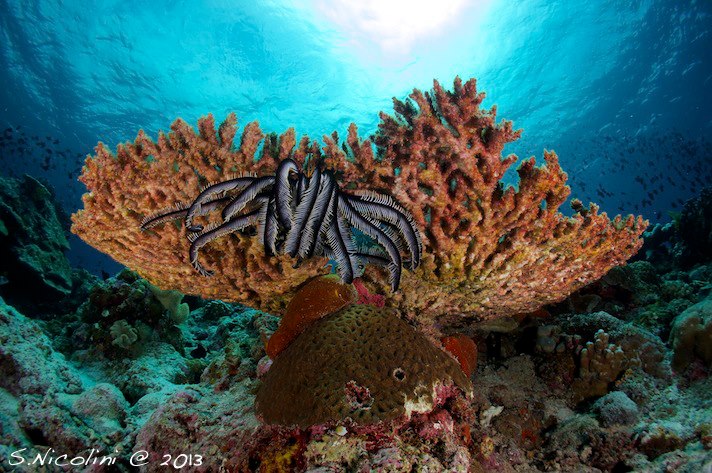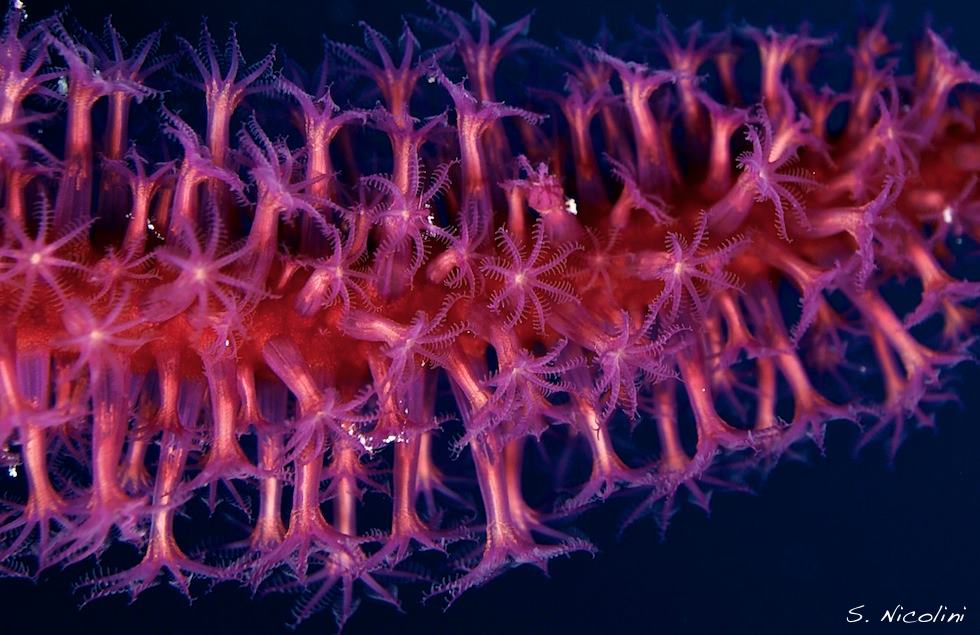
Wakatobi
Wakatobi
Scuba diving in Wakatobi National Park
Wakatobi National Park is a small group of islands in southeast Sulawesi, also known as the Tukangbesi Archipelago, that is home to some of the healthiest coral fields you are likely to see in your diving career. It is a tropical paradise with beautiful beaches and pristine reefs. Some of the best places can only be reached while on liveaboard. The southeastern atolls have been visited by very few divers, and still offer the feeling of remote pioneer-diving
SCUBA DIVING
The coral cover is just excellent -no damage from fishing, boating or diving at any place-. There are huge boulders of hard corals everywhere, sponges the size of a man and sea fans 2 to 3 meter across not much soft corals though. In some places you can find whole fields of whip corals. Being a national park, the local fishing communities obtain a fair share of the income generated by dive tourism in exchange for adopting sustainable practices, which have permitted leaving large stretches of reef completely untouched.

Wakatobi’s reefs are unlike others in the region because of dry climate and uplifted limestone –what’s means fossiled reefs-. Due to the lack of soil erosion there is an exceptionally clean environment here. Many dive sites are not very well known, which are waiting to be discovered, particularly in the outer atolls which are virtually untouched.
March to December is the season for scuba diving in Wakatobi. July and August bring rich plankton blooms and their attendant big marine animals, but also cooler water and lower visibility. The water temperature varies quite a bit. November until May the temperature averages is 28°C, June, July and September are between 26 to 27°C. October registered the maximum of 30°C and August the minimum of 25°C. For 99% of the year, the temperature ranges between 26-29°C.
DIVE SITES
Pasarwajo

This place offers excellent muck diving especially during night dive. Stone fishes, wasp fishes, octopus, Spanish dancer and other large sea slugs and rare nudibranchs, as well as poisonous sea urchins and lionfish.
Hoga
It is the base for the Operation Wallacea which has a research program here. They want to develop a comprehensive management plan to preserve the ecological balance of these islands with its coral reefs and animal life.

There are several dive sites, walls with a lot of islets, caves and overhangs, and pinnacles on top of which there are many trevallies, Jack fishes, eagle rays and barracudas. It is also a great place for a night dive.
Tomia
Just in front of the resort is the best diving in the island, a long beautiful wall very rich in corals and fish life. With well protected schooling fishes and the jetty full of resident fish, the snorkelers find here plenty of attractions without the need for taking a boat. Highlights include a great variety of fishes, invertebrates, macro subjects, beautiful soft corals, gorgonians, tunicates, whips, sponges, overhangs-all totalling a spectacular rainbow of colour. Frequently there are strong and changing currents.
Binongko
The inhabitants of Binongko are skill iron-workers. It is possible to see them making traditional Indonesian “kriss”, the curved blades knives.
Ndaa

This small island south of Binongko offers fantastic walls covered in soft and hard corals. Sea life includes turtles, Jack fishes, scorpion fishes, bat fishes and rays.
Karang Koka
The atoll has two natural entrances, one in the south and the other one on the northeastern side. Coral growth is very dense everywhere and in some places you see gorgonians of enormous size and many black coral. Fish life includes big schools of fish, jacks, dogtooth tuna, napoleons and eagle rays. On some spot could be fierce changing currents.
Moromaho
It’s a small island covered with palm trees. It rises sharply from the sea bottom out of 400m. The flat, large reef top ends abruptly at a more than 60m deep wall dives in front of the island western side are all extremely good, many and big schools of fish, mostly jacks and fusiliers.
The walls have many entrances and overhangs. Everywhere there are big gorgonians, black coral and huge barrel sponges. Currents and down currents could be strong.
DIVING FACTS

Diving season: From March to April and from October to December. The months of March and April, and mid/late-September to early/mid-December are the best times for diving in the Banda Sea -which Wakatobi is-, based upon surface conditions. Rainy season: From January to February and from June to August. Water temperature: 25-30°C. A 3mm shorty should be sufficient. If you feel the cold easily a 5mm shorty is advisable. Visibility: 15m-80m. Depths: 5 -> 50m. Currents: Gentle. Surface conditions: Calm. Experience level: Beginner – intermediate – advanced. Dive sites: >50. Length of stay: Recommended 7-11 days.
TRAVEL INFORMATION

Airport: Kendari. International flight to Bali and then domestic flight to Kendari. Weather: 27-30°C. Indonesia has two seasons: wet and dry. In most of Indonesia the wet season is from October to April and the dry from May to September. Southern Sulawesi rainy season runs from December to March. Best time to visit this area is April to November. Time zone: Sulawesi GMT +8. Transit night & connecting flight: You may need to spend one night in transit in Indonesia before and/or after your cruise, depending on your domestic and international flight schedules. We have the most competitive airfares with the most convenient flight timetables, and hotels for all budgets.
Does it seem complicated? Contact an operator who speaks your language and who can assist you in Indonesia. Feel free to contact us now!
WHERE TO STAY TO DIVE WAKATOBI
There is only one structure that can be considered as diving resort in Wakatobi National Park: Wakatobi Dive Resort and has its own liveaboard to dive the remote dive sites of Wakatobi National Park: Pelagian Liveaboard. Follow the link for further information.
Wakatobi Dive Resort & Pelagian Liveaboard

Wakatobi Dive Resort & Pelagian Liveaboard offer scuba diving in the most remote sites of Wakatobi National Park
Cruising Indonesia | The Liveaboard & Dive Specialists
Cruising Indonesia is committed to ensuring you not only a perfect diving holiday but also the best price guarantee. Contact us and we will arrange everything you need: every single details of your cruise reservation, the international & domestic flights, the ground services, an amazing tour extension…
Reserve Wakatobi now!








